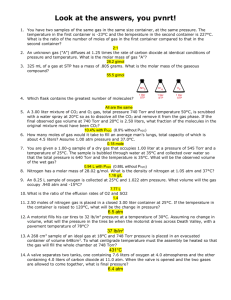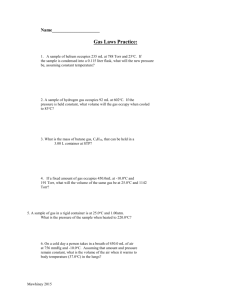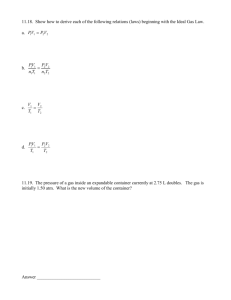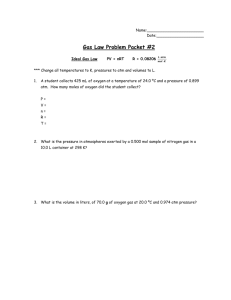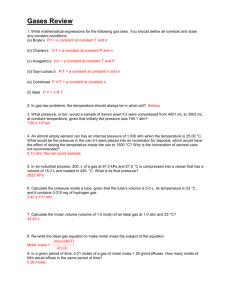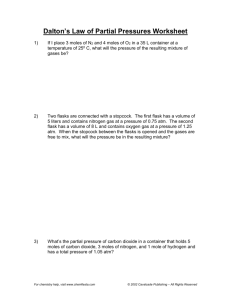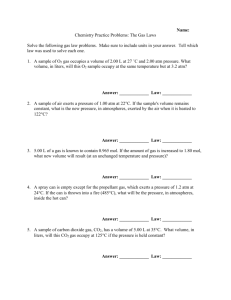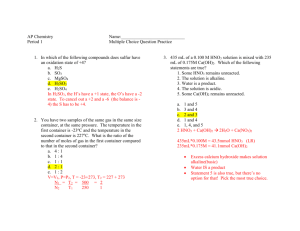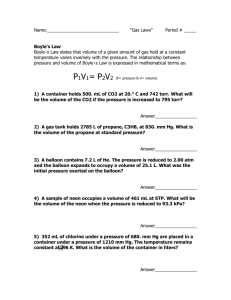Quit looking, you pvnrt
advertisement
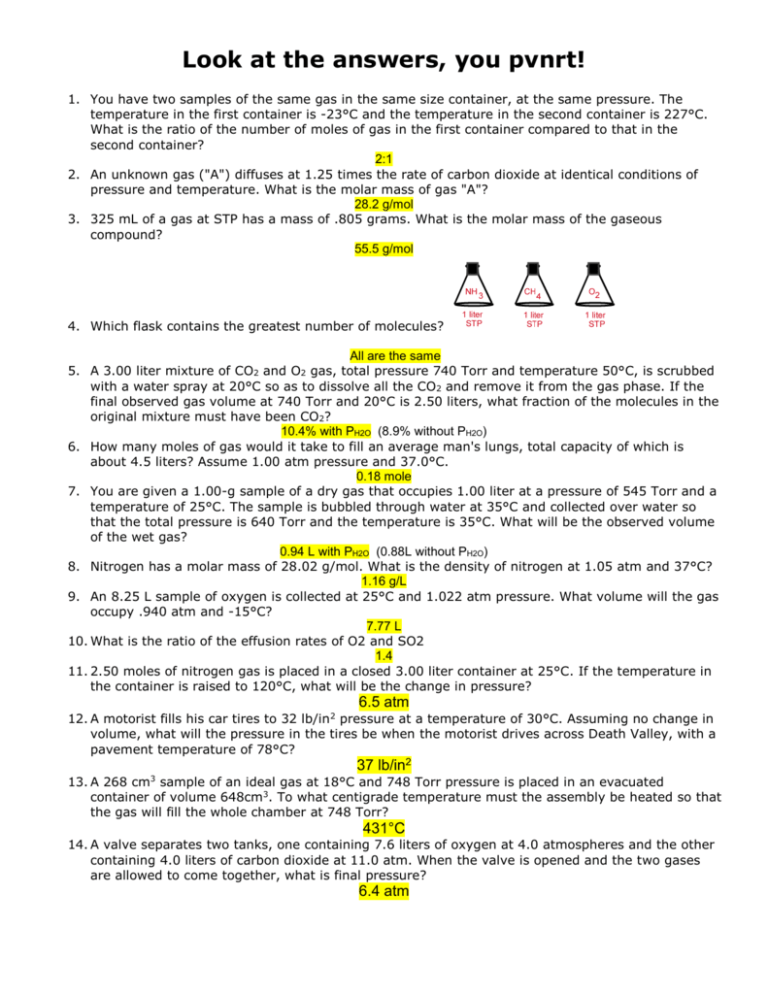
Look at the answers, you pvnrt! 1. You have two samples of the same gas in the same size container, at the same pressure. The temperature in the first container is -23°C and the temperature in the second container is 227°C. What is the ratio of the number of moles of gas in the first container compared to that in the second container? 2:1 2. An unknown gas ("A") diffuses at 1.25 times the rate of carbon dioxide at identical conditions of pressure and temperature. What is the molar mass of gas "A"? 28.2 g/mol 3. 325 mL of a gas at STP has a mass of .805 grams. What is the molar mass of the gaseous compound? 55.5 g/mol 4. Which flask contains the greatest number of molecules? All are the same 5. A 3.00 liter mixture of CO2 and O2 gas, total pressure 740 Torr and temperature 50°C, is scrubbed with a water spray at 20°C so as to dissolve all the CO2 and remove it from the gas phase. If the final observed gas volume at 740 Torr and 20°C is 2.50 liters, what fraction of the molecules in the original mixture must have been CO2? 10.4% with PH2O (8.9% without PH2O) 6. How many moles of gas would it take to fill an average man's lungs, total capacity of which is about 4.5 liters? Assume 1.00 atm pressure and 37.0°C. 0.18 mole 7. You are given a 1.00-g sample of a dry gas that occupies 1.00 liter at a pressure of 545 Torr and a temperature of 25°C. The sample is bubbled through water at 35°C and collected over water so that the total pressure is 640 Torr and the temperature is 35°C. What will be the observed volume of the wet gas? 0.94 L with PH2O (0.88L without PH2O) 8. Nitrogen has a molar mass of 28.02 g/mol. What is the density of nitrogen at 1.05 atm and 37°C? 1.16 g/L 9. An 8.25 L sample of oxygen is collected at 25°C and 1.022 atm pressure. What volume will the gas occupy .940 atm and -15°C? 7.77 L 10. What is the ratio of the effusion rates of O2 and SO2 1.4 11. 2.50 moles of nitrogen gas is placed in a closed 3.00 liter container at 25°C. If the temperature in the container is raised to 120°C, what will be the change in pressure? 6.5 atm 12. A motorist fills his car tires to 32 lb/in pressure at a temperature of 30°C. Assuming no change in volume, what will the pressure in the tires be when the motorist drives across Death Valley, with a pavement temperature of 78°C? 2 37 lb/in2 13. A 268 cm sample of an ideal gas at 18°C and 748 Torr pressure is placed in an evacuated container of volume 648cm3. To what centigrade temperature must the assembly be heated so that the gas will fill the whole chamber at 748 Torr? 3 431°C 14. A valve separates two tanks, one containing 7.6 liters of oxygen at 4.0 atmospheres and the other containing 4.0 liters of carbon dioxide at 11.0 atm. When the valve is opened and the two gases are allowed to come together, what is final pressure? 6.4 atm 15. Consider the following reaction: 2NH3(g) + 3O2(g) ---> N2O3(g) + 3H2O(g) 2.25 moles of ammonia and 1.75 moles of oxygen are placed in a 24.0 Liter container at a temperature of 25.0 °C. The above reaction goes to completion, and is accompanied by a temperature increase to 55.0 °C. What is the final pressure in the flask? 3.82 atm 16. A rigid 3.55 L flask contains a mixture of 1.50 moles of H2, 4.50 mole of O2, and sufficient Ar so that the partial pressure of Ar in the flask is 2.00 atm. The temperature is 127.0 °C. a) Calculate the total pressure in the flask. 57.5 atm b) Calculate the density (in g/L) of the mixture in the flask. 43.8 g/L
